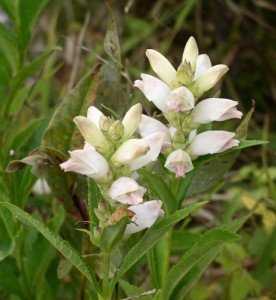Turtlehead – September 2016 Wildflower of the Month
These flowers are well named because when viewed from the side, they look just like a turtle with its mouth open; the “mouth” actually opens when the sides are pushed in. White and tinged with pink, the flowers are one inch long in short spikes at the ends of 1-3-foot stems. Dark green leaves are paired on the stem, narrow and with coarse teeth. Deer won’t eat this plant because the foliage has a bitter taste.
These native perennials like partial shade or full sun and areas with rich soil, and lots of humus and mulch to hold in moisture. Turtleheads usually grow erect, but might need some support in deep shade. They will grow shorter when pinched back in the spring. They can be grown in containers, but the pot should have a saucer of water at all times.
Turtleheads grow naturally on the Coastal Plain along streambanks, in wet meadows, swamps, and marshes. They occur in every state in Virginia and throughout eastern U.S. and Canada. Nurseries and garden centers offer cultivars of this plant and other species with shades of pink. The funnel-shaped flowers are attractive to butterflies and other long-tongued insects, and sometimes hummingbirds.
These are plants for a rain garden, or moist perennial border, providing late-summer flowers for insects preparing for winter. With large white blossoms, these plants look wonderful in wetland gardens with Cardinal Flower, Blue Flag and Cinnamon Fern.
The distinctive shape of this flower is reflected in the genus name, derived from the Greek chelone, “a tortoise”.
By Helen Hamilton, past-president of the John Clayton Chapter, VNPS
Photo: Turtlehead (Chelone glabra) taken by Helen Hamilton

